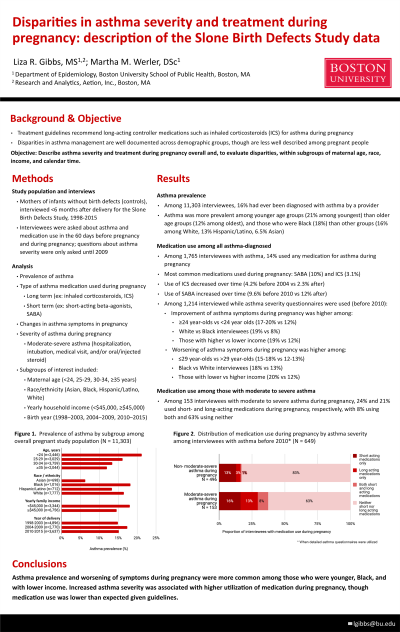Pregnancy and lactation
Session: Poster Session B
(255) Disparities in asthma severity and treatment during pregnancy: description of the Slone Birth Defects Study data
Tuesday, August 27, 2024
8:00 AM - 6:00 PM CEST
Location: Convention Hall II

- LG
Liza R. Gibbs, MS
Director
Aetion, Inc, United States - MW
Martha Werler, DSc
Department of Epidemiology, Boston University School of Public Health, United States
Presenting Author(s)
Co-Author(s)
Background: Treatment guidelines recommend use of long-acting controller medications such as inhaled corticosteroids (ICS) for asthma during pregnancy. Disparities in asthma management are well documented across demographic groups, though the extent of these disparities among pregnant people are less well described.
Objectives: To describe asthma severity and treatment during pregnancy overall and among maternal age, race, income, and calendar time strata to evaluate disparities in severity and treatment.
Methods: Using maternal interview data from the Slone Birth Defects Study (1998-2015), we described reported asthma in mothers of infants without birth defects (controls). Within 6 months after delivery, all interviewees were asked about occurrence of asthma and medication use before and during pregnancy; questions on asthma severity were only asked until 2009. Among those with asthma overall and with an indicator of moderate-severe asthma during pregnancy (hospitalization, intubation, medical visit, or oral/injected steroid), we compared prevalence of medication use according to demographic factors, including maternal age ( < 24, 25-29, 30-34, ≥35 years), race, income ( <$45k, ≥$45k yearly household income), and calendar year.
Results: Among 12,312 interviewees, 1,891 (15%) were ever diagnosed with asthma by a provider. Asthma was more prevalent among younger than older age groups (21% youngest to 13% oldest) and those who were Black (19%, vs 16% among White, 12% Hispanic/Latino, 6.6% Asian). Among 1,891 interviewees with asthma, 14% used any medication for asthma during pregnancy, most commonly short acting beta-agonists (SABA) (11%) and ICS (3.1%). Use of ICS decreased over time (4.3% before 2004 vs 2.0 - 2.4% after), while use of SABA increased over time (8.6 - 9.9% before 2010 vs 13% after). Among N=1,226 with asthma interviewed before 2010, improvement of asthma symptoms during pregnancy was more common among those who were older (17-20% age ≥24 years vs 12% < 24 years), White (19%, vs 5.1% among Black), and had higher income (20% among highest, 12% lowest), while worsening of symptoms was more common among those who were younger (20% youngest to 13% oldest), Black (19%, vs 14% among White), and had lower income (21% among lowest, 12% highest). Among N=153 with moderate-severe asthma during pregnancy, 24% and 21% used short- and long-acting medications during pregnancy, respectively, with 8% using both and 63% using neither.
Conclusions: Asthma prevalence and worsening of symptoms during pregnancy were more common among those who were younger, Black, and with lower income. Increased asthma severity was associated with higher utilization of medication during pregnancy, though medication use was lower than expected given guidelines.
Objectives: To describe asthma severity and treatment during pregnancy overall and among maternal age, race, income, and calendar time strata to evaluate disparities in severity and treatment.
Methods: Using maternal interview data from the Slone Birth Defects Study (1998-2015), we described reported asthma in mothers of infants without birth defects (controls). Within 6 months after delivery, all interviewees were asked about occurrence of asthma and medication use before and during pregnancy; questions on asthma severity were only asked until 2009. Among those with asthma overall and with an indicator of moderate-severe asthma during pregnancy (hospitalization, intubation, medical visit, or oral/injected steroid), we compared prevalence of medication use according to demographic factors, including maternal age ( < 24, 25-29, 30-34, ≥35 years), race, income ( <$45k, ≥$45k yearly household income), and calendar year.
Results: Among 12,312 interviewees, 1,891 (15%) were ever diagnosed with asthma by a provider. Asthma was more prevalent among younger than older age groups (21% youngest to 13% oldest) and those who were Black (19%, vs 16% among White, 12% Hispanic/Latino, 6.6% Asian). Among 1,891 interviewees with asthma, 14% used any medication for asthma during pregnancy, most commonly short acting beta-agonists (SABA) (11%) and ICS (3.1%). Use of ICS decreased over time (4.3% before 2004 vs 2.0 - 2.4% after), while use of SABA increased over time (8.6 - 9.9% before 2010 vs 13% after). Among N=1,226 with asthma interviewed before 2010, improvement of asthma symptoms during pregnancy was more common among those who were older (17-20% age ≥24 years vs 12% < 24 years), White (19%, vs 5.1% among Black), and had higher income (20% among highest, 12% lowest), while worsening of symptoms was more common among those who were younger (20% youngest to 13% oldest), Black (19%, vs 14% among White), and had lower income (21% among lowest, 12% highest). Among N=153 with moderate-severe asthma during pregnancy, 24% and 21% used short- and long-acting medications during pregnancy, respectively, with 8% using both and 63% using neither.
Conclusions: Asthma prevalence and worsening of symptoms during pregnancy were more common among those who were younger, Black, and with lower income. Increased asthma severity was associated with higher utilization of medication during pregnancy, though medication use was lower than expected given guidelines.
